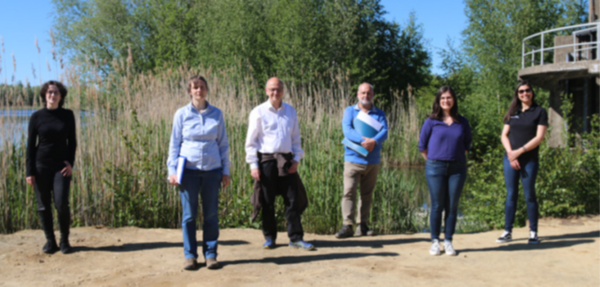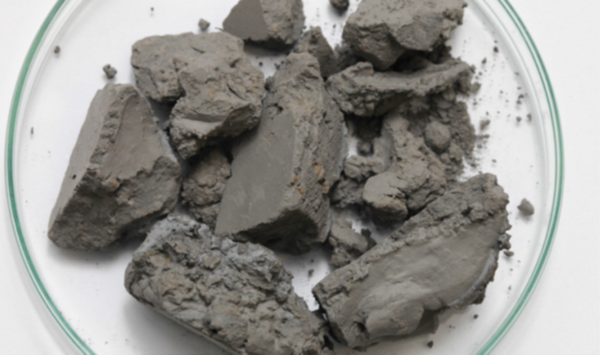REMINTA
REMINTA - From contaminated site to reusable material store
Resource-efficient circular economy - construction and mineral material cycles (ReMin)
In the REMINTA project, mineral residues from the Rammelsberg ore mine stored in tailings ponds are to be processed and refined. The aim is to develop an overall recycling concept that takes into account the three pillars of sustainability (social, ecological and economic).
The project is being funded as part of the "Resource-efficient circular economy - construction and mineral material cycles (ReMin)" funding measure. "ReMin" is part of the BMBF research concept "Resource-efficient circular economy" and is aimed at resource-efficient construction and the expanded use of mineral secondary raw materials from construction waste, slag, ash and mining residues.
From contaminated site to reusable material store
Decades of processing finely ground ores from the Rammelsberg mine, which in addition to copper, lead and zinc also contained considerable amounts of precious and special metals, have resulted in large quantities of overburden (tailings) in the so-called tailings ponds at Bollrich near Goslar. REMINTA is pursuing the goal of designing a process for the recovery and recycling of a maximum proportion of these residues.
The central innovation and extension of the approach developed in the predecessor project REWITA for the extraction of economically strategic metals is the additional utilization of mineral fractions from the tailings pond materials - in addition to Wissenbach slate, an estimated 1.3 million tons of barite. This is to be achieved through further processing of the mineral residues of the process developed in the REWITA project.
By separating out the pollutants or valuable material concentrates contained in this, it will be possible to use mineral fractions in the production of building materials or directly as a secondary raw material in the context of landfill, dam and dyke construction measures. This conserves primary resources and enables recycling. Further positive side effects such as the revitalization of the ecosystem, the creation of jobs and the minimization of risks from landfilling are expected.

Work steps and partners
Through further processing steps such as flotation, grinding, chemical and biological leaching, dewatering and drying, the mineral waste fractions of the REWITA project are to be conditioned in such a way that they can largely be converted into building materials or building material components. The TU Clausthal (IFAD, IGE) and the Helmholtz Institute Freiberg for Resource Technology Freiberg are conducting research into this.
The companies Geiger, Geocycle, IBU-tec and the CUTEC Clausthal Environmental Technology Research Center at Clausthal University of Technology are examining and evaluating possible uses for the treated minerals in the cement industry and in landfill sealing construction. If other possible applications arise within the scope of the project, these will be considered accordingly.
Furthermore, on this basis, taking into account the results from the REWITA project, a planning and holistic evaluation for the complete resumption of the tailings pond will be carried out. These include a complete, integrated processing route, including sulphide and barite extraction and treatment. The social aspects will be considered by the Harz University of Applied Sciences.
The digitalization approaches from the REWITA project will be further developed so that the process control of the overall project can be mapped. In addition, the business models are to be developed with regard to investment decisions and the measures now required to secure acceptance among the population for implementation. The aspects of digitalization are being handled by pdv-software.
Finally, based on the results of the REMINTA and REWITA projects, a joint guideline for the reprocessing of tailings ponds is to be developed.

Utilization of the results
The scientific and technical innovation of the project consists of the first-time development and adaptation of new extraction and processing methods and techniques for the collection and extraction of a secondary raw material deposit in the form of a tailings pond. This will be concluded with the extensive utilization of all components contained in the generation of mineral raw material substitutes in the fine grain range for applications in cement production, dam sealing and landfill construction from mining residues.
Recommendations for action for similar mining residues can be derived from the overall experience gained and scientific results. These are incorporated into the above-mentioned guideline, which can thus serve as a model for remediation measures at tailings ponds worldwide.
Funding measure
Resource-efficient circular economy - construction and mineral material cycles (ReMin)
Project title
REMINTA - REcycling MINeral fractions from TAilings using the example of the tailings pond at Bollrich in Goslar
Duration
01.02.2021-31.01.2024
Funding reference
033R266
Funding volume of the network
1,410,254 euros
Contact
Prof. Dr.-Ing. Daniel Goldmann
Clausthal University of Technology | Faculty of Energy and Economics - Institute of Mineral Processing, Landfill Technology and Geomechanics
Walther-Nernst-Straße 9 | 38678 Clausthal-Zellerfeld
Phone: 05323 72-2735
Email: daniel.goldmann@tu-clausthal.de
Project partners
Helmholtz-Zentrum Dresden; Rossendorf e. V.; Helmholtz Institute Freiberg for Resource Technology; Geocycle (Deutschland) GmbH; Harz University of Applied Sciences; Geiger Unternehmensgruppe; IBU-tec advanced materials AG; pdv-software GmbH
Internet
reminta.de
Data sheet
Download data sheet